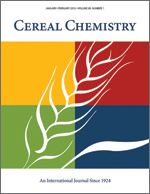
Cereal Chem 69:452-455 | VIEW
ARTICLE
Stucture of Glutenin Based on Farinograph and Electrophoretic Results.
L. Gao, P. K. W. Ng, and W. Bushuk. Copyright 1992 by the American Association of Cereal Chemists, Inc.
The objective of this study was to obtain additional information on the molecular structure of glutenin in relation to its functionality in doughs during breadmaking. In this context, doughs from the flour of the Canadian hard red spring wheat cultivar Katepwa were mixed in a farinograph in the absence and presence of a disulfide reducing agent, dithiothreitol (DTT). The glutenin of the control dough and of the partially reduced dough was examined by sodium dodecyl sulfate-polyacrylamide gel electrophoresis (SDS-PAGE) without and with reduction during electrophoretic analysis. At a low concentration of DTT (20 micromols/50 g of flour), the farinograph properties were markedly affected, but no high molecular weight (HMW) subunits were liberated as indicated by SDS-PAGE without reduction. At higher concentrations of DTT (80-3,000 micromols/50 g of flour), several types of glutenin subunit oligomers and all of the oligomer subunits (2*, 5, 7, 9, and 10) were liberated gradually with increasing DTT concentration. HMW glutenin oligomers as three close-moving bands in SDS-PAGE, with molecular weights higher than that of the largest HMW subunit (2*), were observed for doughs treated with the higher concentrations of DTT. On the basis of their apparent molecular weights, the three bands appear to be dimers composed of subunits as follows: 2*+7, 2*+9, and 5+10. The results of this study are consistent with a "block" model of the molecular structure of glutenin.